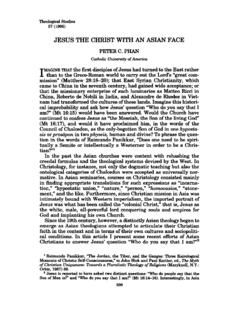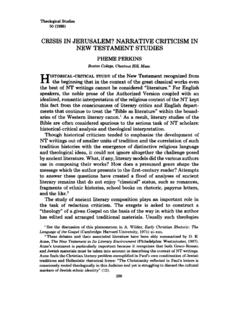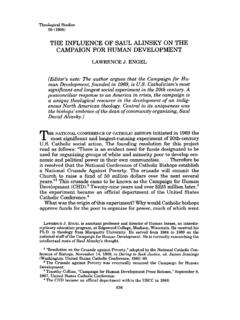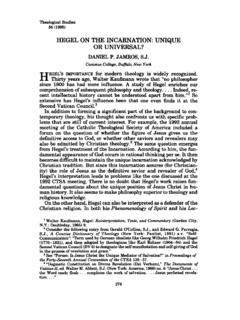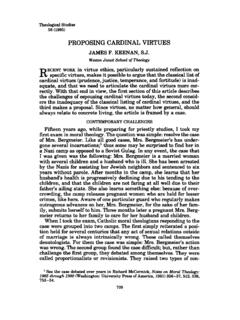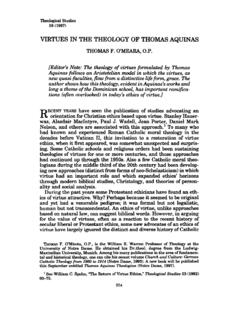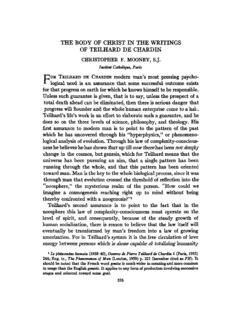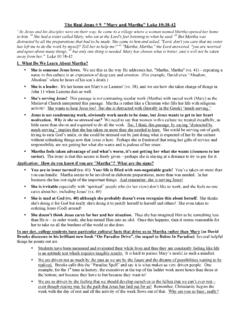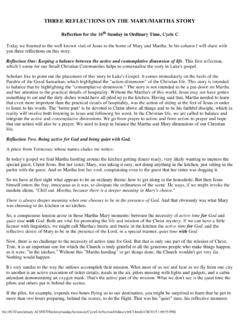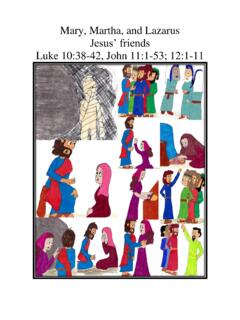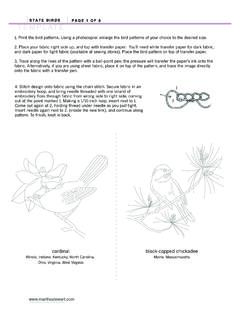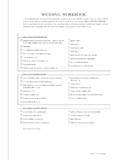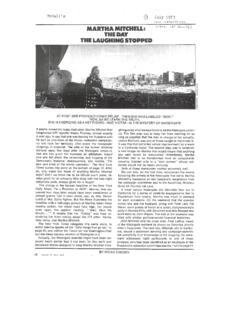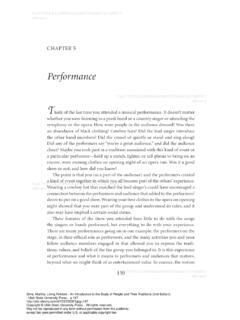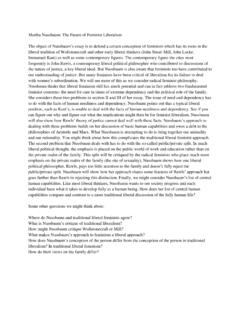Transcription of MARTHA NUSSBAUM AND THOMAS AQUINAS ON THE …
1 MARTHA NUSSBAUM AND THOMAS AQUINAS ONTHE EMOTIONSCARLOLEGET[ MARTHA NUSSBAUM in herUpheavals of Thought: The Intelligenceof Emotionspresents a philosophical theory of emotions that inter-acts with contemporary research in other sciences. Although she hasdrawn upon the same Aristotelian and Stoic sources as did ThomasAquinas, she pays scarce attention to his work. The purpose of thispresent article is to explore the extent to which NUSSBAUM s bookcould profit from closer utilization of AQUINAS , and, at the sametime, could broaden the insights of AQUINAS s work.]In her bookUpheavals of Thought: The Intelligence of Emotions, MarthaNussbaum presents a well argued philosophical theory of book offers extensive and noteworthy discussions with various ancientand contemporary theories of emotions in order to show the relevance ofemotions for moral philosophy.
2 Given, however, NUSSBAUM s historicalinterest and the Aristotelian and Stoic traditions she draws upon, it issurprising that in her study hardly any attention is paid to the work ofThomas AQUINAS . AQUINAS s account not only belonged to the very sameintellectual tradition upon which NUSSBAUM builds; he also composed themost extensive treatise on emotions in his day, one that has had a consid-erable influence on later Western his from the Catholic Theological University atUtrecht, The Netherlands. His doctoral dissertation was published asLiving withGod: THOMAS AQUINAS on the Relation between Life on Earth and Life after Death(Peeters, 1997).
3 He is currently associate professor of medical ethics in the depart-ment of ethics, philosophy and history of medicine at the University Medical CentreNijmegen. He has published bilingual editions (Latin-Dutch) of AQUINAS sSermonson the Ten Commandments(Meinema, 1999) and of AQUINAS sSermons on theLord s Prayer and Hail Mary(Meinema, 2000), as well as a number of articlesespecially on end-of-life C. NUSSBAUM ,Upheavals of Thought: The Intelligence of Emotions(New York: Cambridge University, 2001). The title of the book refers to a passagein Marcel Proust sRemembrance of Things Pastwhere emotions are compared withgeological upheavals that shape the landscape of our mental and social Mark Jordan points out, AQUINAS s treatise on the passions of the souldisplays a rather selective use of sources (Mark Jordan, AQUINAS s Construction ofa Moral Account of the Passions, Freiburger Zeitschrift fu r Philosophie und The-Theological Studies64 (2003))
4 558 Whatever AQUINAS s contribution to NUSSBAUM s theory of emotionmight have been, in this article the main focus of interest lies in the oppo-site direction. The thought of AQUINAS , and not in the least his attention tothe impact of emotions in moral action, is still of major importance forcontemporary moral the 13th century however things as AQUINAS developed his account of emotions in dialoguewith the best sources available in his day, so should we in our s discussion with a wide variety of contemporary authors onpsychology and human (and animal) behavior provides a valuable resourcefor evaluating AQUINAS s the extensive corpus of writings from both AQUINAS and Nuss-baum, my exploration remains limited but , I intro-duce NUSSBAUM s theory of emotion by giving an overview of the contentof her book, often in her own words.
5 Thus a framework for the discussionof details is designed and elements needed for the second section of mystudy are highlighted. My second part is devoted to the question howNussbaum s neo-Stoic account might shed light on the problems and per-spectives of using AQUINAS s theory of emotion [1986] 71-97). For the sources of AQUINAS s treatise on the passions of thesoul, see also Alexander Brungs,Metaphysik der Sinnlichkeit: Das System der Pas-siones Animae bei THOMAS von Aquin(Halle: Hallescher Verlag, 2002).3 See Servais Pinckaers, Les passions et la morale, Revue des sciences phi-losophiques et the ologiques74 (1990) 379-91.
6 Apart from philosophical and histori-cal considerations, important theological reasons for studying AQUINAS nowadaysinclude the power and flexibility of his intellectual heritage, and the ongoing impactof his thought on the official teaching of the Roman Catholic lie Oksenberg Rorty, From Passions to Emotions and Sentiments, Phi-losophy57 (1982) 159-72. See also her Aristotle on the Metaphysical Status ofPathe, Review of Metaphysics38 (1984) 521-46 where she sketches the story be-ginning with classical example of this approach is Stephanus Pfu rtner,Triebleben undsittliche Vollendung:Eine moralpsychologische Untersuchung nach THOMAS vonAquin(Fribourg: Universita tsverlag, 1958).
7 Pfu rtner is in dialogue with D. Katz, Uexku ll, W. McGougal, and S. Freud. Some critical corrections to Pfu rtner sstudy can be found in Alexander Brungs,Metaphysik der Sinnlichkeit(n. 2 above).6 Upheavals of Thoughtis composed of 16 chapters, more than half of whichwere previously published in a somewhat different form during the 1990s. Here Ifocus only on this 750-page book that can be considered as a unit in which the entirerange of the author s scholarly attention is represented: from ancient Greek tomodern literature, from ethical-political to feminist and global developmental is-sues, including discussions with scholars and scientists from various an overview of AQUINAS s theory ofpassiones animae, see Peter King, AQUINAS on the Passions, inAquinas s Moral Theory, ed.
8 Scott MacDonald andEleonore Stump (Ithaca, : Cornell University, 1999) 101-32; G. Simon Harak,Virtuous Passions: The Formation of Christian Character(New York: Paulist, 1993);559 NUSSBAUM AND AQUINAS ON THE EMOTIONSNUSSBAUM S NEO-STOIC ACCOUNTN ussbaum s book consists of three parts. In the first part, in which littleis written about normative questions, she develops her own cognitive viewon emotions. In the second and third part, she focuses on compassion (part2) and love (part 3) in order to deal with three problems that are posed byher account and that might lead toward a rejection of the role emotions canplay in normative judgments.
9 These three problems concern (a) the vul-nerability that is revealed by emotions, compromising the dignity of humanagency; (b) the partial and unbalanced viewpoint of emotions as they de-velop in connection with particular attachments in early childhood; and (c)the ambivalence of emotions toward their objects, stemming from the mor-ally subversive combination of love and 1: Need and RecognitionNussbaum develops her theory of emotion in a few stages. In the firstchapter she presents its general structure, which in turn is refined andreshaped during the next four chapters. In her view, emotions involvejudgments about important things, judgments in which, appraising an ex-ternal object as salient for our own well-being, we acknowledge our ownneediness and incompleteness before parts of the world that we do not fullycontrol.
10 8 Beginning with an autobiographical story of loss and grief anddeveloping her view in discussion with accounts that consider emotions asunthinking bodily energies, she makes clear that emotions always imply anobject, are intentional by nature, embody certain beliefs about the object,and are concerned with value. Emotions eventually tell about a person sflourishing, and are as such eudaimonistic (in the sense of ancient Greek,hence the spelling) by nature. They look at the world from the subject sown calls her view neo-Stoic, because she modifies the Stoic ac-count of emotions as evaluative judgments in a number of ways that differfrom her ancient Greek predecessors.
